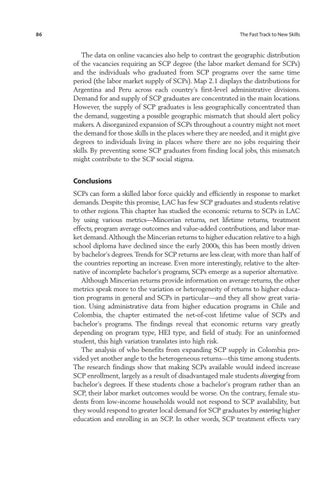86
The Fast Track to New Skills
The data on online vacancies also help to contrast the geographic distribution of the vacancies requiring an SCP degree (the labor market demand for SCPs) and the individuals who graduated from SCP programs over the same time period (the labor market supply of SCPs). Map 2.1 displays the distributions for Argentina and Peru across each country’s first-level administrative divisions. Demand for and supply of SCP graduates are concentrated in the main locations. However, the supply of SCP graduates is less geographically concentrated than the demand, suggesting a possible geographic mismatch that should alert policy makers. A disorganized expansion of SCPs throughout a country might not meet the demand for those skills in the places where they are needed, and it might give degrees to individuals living in places where there are no jobs requiring their skills. By preventing some SCP graduates from finding local jobs, this mismatch might contribute to the SCP social stigma.
Conclusions SCPs can form a skilled labor force quickly and efficiently in response to market demands. Despite this promise, LAC has few SCP graduates and students relative to other regions. This chapter has studied the economic returns to SCPs in LAC by using various metrics—Mincerian returns, net lifetime returns, treatment effects, program average outcomes and value-added contributions, and labor market demand. Although the Mincerian returns to higher education relative to a high school diploma have declined since the early 2000s, this has been mostly driven by bachelor’s degrees. Trends for SCP returns are less clear, with more than half of the countries reporting an increase. Even more interestingly, relative to the alternative of incomplete bachelor’s programs, SCPs emerge as a superior alternative. Although Mincerian returns provide information on average returns, the other metrics speak more to the variation or heterogeneity of returns to higher education programs in general and SCPs in particular—and they all show great variation. Using administrative data from higher education programs in Chile and Colombia, the chapter estimated the net-of-cost lifetime value of SCPs and bachelor’s programs. The findings reveal that economic returns vary greatly depending on program type, HEI type, and field of study. For an uninformed student, this high variation translates into high risk. The analysis of who benefits from expanding SCP supply in Colombia provided yet another angle to the heterogeneous returns—this time among students. The research findings show that making SCPs available would indeed increase SCP enrollment, largely as a result of disadvantaged male students diverging from bachelor’s degrees. If these students chose a bachelor’s program rather than an SCP, their labor market outcomes would be worse. On the contrary, female students from low-income households would not respond to SCP availability, but they would respond to greater local demand for SCP graduates by entering higher education and enrolling in an SCP. In other words, SCP treatment effects vary

